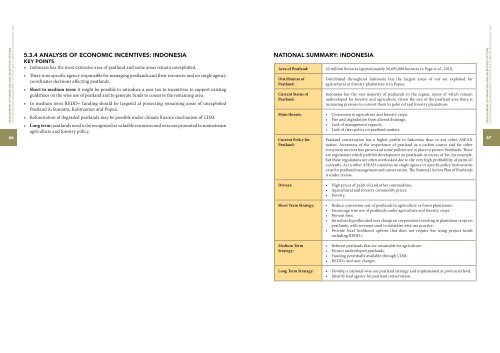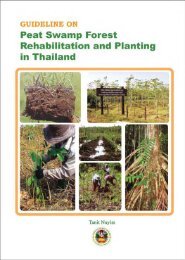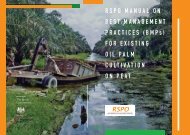Untitled - Peat Portal
Untitled - Peat Portal
Untitled - Peat Portal
You also want an ePaper? Increase the reach of your titles
YUMPU automatically turns print PDFs into web optimized ePapers that Google loves.
DEVELOPMENT OF FINANCING AND INCENTIVES OPTIONSFOR SUSTAINABLE MANAGEMENT OF PEATLAND FORESTS IN SOUTHEAST ASIA665.3.4 ANALYSIS OF ECONOMIC INCENTIVES: INDONESIAKEY POINTS• Indonesia has the most extensive area of peatland and some areas remain unexploited.• There is no specific agency responsible for managing peatlands and their resources and no single agencycoordinates decisions affecting peatlands.• Short to medium term: it might be possible to introduce a user tax to incentivise to support existingguidelines on the wise use of peatland and to generate funds to conserve the remaining area.• In medium term REDD+ funding should be targeted at protecting remaining areas of unexploited<strong>Peat</strong>land in Sumatra, Kalimantan and Pupua.• Reforestation of degraded peatlands may be possible under climate finance mechanism of CDM.• Long term: peatlands need to be recognised as valuable resources and wise use promoted in mainstreamagriculture and forestry policy.NATIONAL SUMMARY: INDONESIAArea of <strong>Peat</strong>land: 20 million hectares (approximately 20,695,000 hectares in Page et al., 2011).Distribution of<strong>Peat</strong>land:Current Status of<strong>Peat</strong>land:Distributed throughout Indonesia but the largest areas of not yet exploited foragricultural or forestry plantations is in Papua.Indonesia has the vast majority of peatlands in the region, many of which remainundeveloped for forestry and agriculture. Given the size of the peatland area there isincreasing pressure to convert them to palm oil and forestry plantations.Main threats: • Conversion to agriculture and forestry crops.• Fire and degradation from altered drainage.• Lack of management capacity.• Lack of clear policy on peatland matters.Current Policy for<strong>Peat</strong>land:<strong>Peat</strong>land conservation has a higher profile in Indonesia than in any other ASEANnation. Awareness of the importance of peatland as a carbon source and for otherecosystem services has grown and some policies are in place to protect <strong>Peat</strong>lands. Thereare regulations which prohibit development on peatlands in excess of 3m, for example,but these regulations are often overlooked due to the very high profitability of palm oilcurrently. As in other ASEAN countries no single agency or specific policy instrumentsexist for peatland management and conservation. The National Action Plan of <strong>Peat</strong>landsis under review.DEVELOPMENT OF FINANCING AND INCENTIVES OPTIONSFOR SUSTAINABLE MANAGEMENT OF PEATLAND FORESTS IN SOUTHEAST ASIA67Drivers: • High prices of palm oil and other commodities.• Agricultural and forestry commodity prices.• Poverty.Short Term Strategy: • Reduce conversion rate of peatlands to agriculture or forest plantations.• Encourage wise use of peatlands under agriculture and forestry crops.• Prevent fires.• Introduce hypothecated user charge on corporation investing in plantation crops onpeatlands, with revenues used to subsidise wise use practice.• Provide local livelihood options that does not require fire using project fundsincluding REDD+.Medium TermStrategy:• Reforest peatlands that are unsuitable for agriculture.• Protect undeveloped peatlands.• Funding potentially available through CDM.• REDD+ and user charges.Long Term Strategy: • Develop a national wise use peatland strategy and implemented at provincial level.• Identify lead agency for peatland conservation.





